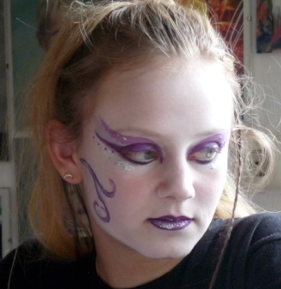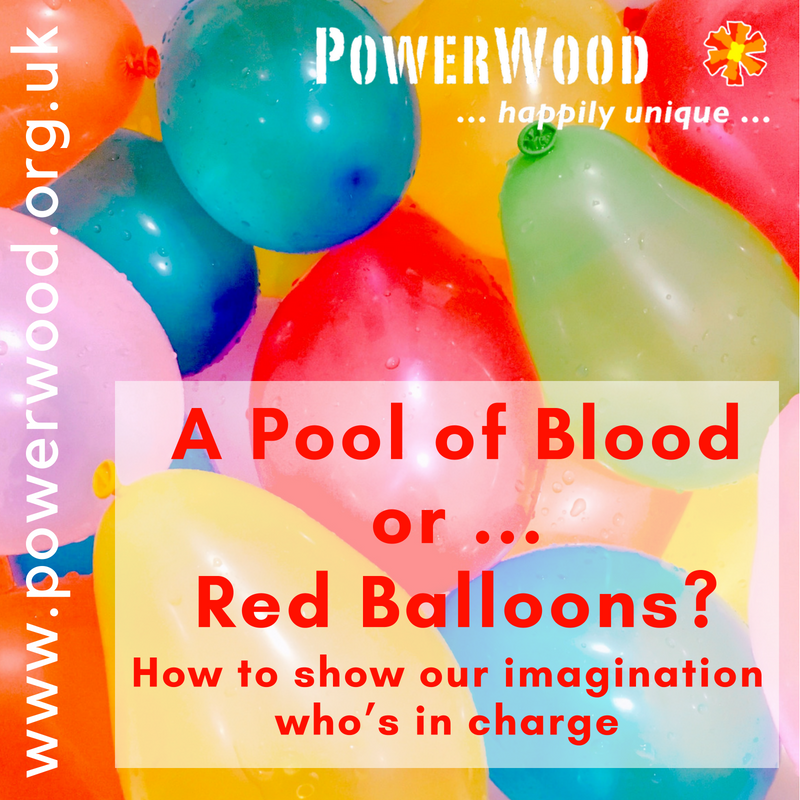Understanding imaginational and emotional OE
 At PowerWood Camp late one night a mum with her young daughter came to see me around the communal fire. Mum felt quite desperate. Her daughter (7yrs) couldn’t sleep because every time she closed her eyes she would see her mum in the middle of a big pool of blood. The little girl was completely distraught by the idea that her mum would be dead, and dreaded entering the tent.
At PowerWood Camp late one night a mum with her young daughter came to see me around the communal fire. Mum felt quite desperate. Her daughter (7yrs) couldn’t sleep because every time she closed her eyes she would see her mum in the middle of a big pool of blood. The little girl was completely distraught by the idea that her mum would be dead, and dreaded entering the tent.
I talked for a while with the terrified girl in her pyjamas. I acknowledged her fear of losing her mum (later I understood there had been a loss in the family), and hovered above the experience together with her by asking what she saw exactly, forcing her to think. In the process of using the intellectual part of her brain she started to calm down. When she was calmer I explained that she was the boss of her imagination, so it was up to her what she was imagining. She could decide what she was going to see.
The next morning she came happily running to me and shouted the tent had been full of red balloons and she wasn’t afraid anymore.
Frighteningly Real
If you have both imaginational and emotional OE you can imagine both positive and negative worlds, scenarios and outcomes in surprisingly sharp detail, way beyond what people normally imagine. This imagination can be blissfully – or frighteningly – tangible.
Probably all individuals worry, but individuals with OE often worry about a much wider range of things, which can be combined with high levels of anxiety and may even have psychotic fringes.
I would like to say that I see all the worries expressed by the people I work with as real worries and I take those worries seriously. Most serious worries are related to the world and its future for humankind, and personal relationships.
However worries shouldn’t drain our energy. We need our energy to be able to make our own tiny little steps towards dealing with the worry. We don’t want to lose any energy if we can prevent it.
These self-created or recreated worlds aren’t only colourful and three, four, five and more dimensional, but can also be connected with distinct smells which can further trigger imaginary visions. This might ignite a whole different constantly changing spectrum of feelings, premonitions and epiphanies, and can be related to sounds and tastes in every little detail imaginable.
Yes to Imagination!
To have this ability to create positive imaginary worlds is a huge asset. You can create soothing places where you can go to lick your wounds and/or reenergise and get back into contact with your content, quiet self.
You can embrace this ability or try to keep it at bay as it can be so overwhelming.
Embracing this ability to imagine and feel so deeply and vividly can be an astonishingly complex and appealing experience, often preferable to reality, as it is much more satisfying to the senses when it is positive and even when it is negative. When all the senses are triggered and connected, people feel ‘alive’ as their deep need and urge for intensity is satisfied.
We are all evolutionarily inclined to focus on the negative, as that has survival value. It’s so much easier to remember negative than positive experiences; before we know it our attention is focussed on the negative and it takes energy to change this.
Young people, teens and children with OE worry about the future of the earth, about climate change, about what will happen when their mother dies, what will happen when they can’t find a job or be able to deal with adult responsibilities, what will happen when they haven’t done the right homework or not in the intended way and myriad other things.
Often they manage to keep their negative imagination at bay during the day with activities such as keeping busy, dissociating behind the computer, or overeating to numb themselves. Then just before bedtime they have to relax and they can’t sleep because their worry overwhelms them. Often they will try to postpone going to bed until they are so exhausted that they can skip this moment of self-realisation.
What’s happening?
When you have a combination of imaginational and emotional OE experiences can be overwhelming because you have the ability to feel as if your imagination is real, NOW.
As an adult you may feel that you’re not in charge of your own mental processes as your not helpful train of thought takes over and defines where your attention goes. You lose a lot of energy and your imagination might recreate an old fear for your safety, which can trigger an acute stress response: fight, flight, freeze or fawn (need to please).
This hyperarousal, caused by adrenaline pumping through your body, is a physiological reaction that occurs in response to a perceived harmful event, attack, or threat to survival. You can’t sleep properly anymore or relax or trust that everything will be all right. You might have panic attacks or night terrors.
You can get stuck in this super-alert state, with no strong sense of self or belonging or sense of reality as your imaginary world is so strong and re-triggers your fight-or-flight, freeze or fawn response continuously. This state can feel so overwhelming that you may feel you can never ever change it. Fortunately there are small steps you can take to get back in charge again.
3 Steps to break the constant alert chain that drains our energy
Step 1 ►Damage Control, to prevent any unnecessary escalation
 A short breathing exercise of 60 second is all it takes. You can make the exercise even stronger by placing the tip of your tongue in between your teeth and your palate. If you have psychomotor OE, tense all your muscles as much as you can during the 7 counts you are holding your breath, and then relax with the 8 counts out. If after doing this you feel slightly calmer and more grounded, continue with the following step. Otherwise repeat Step 1.
A short breathing exercise of 60 second is all it takes. You can make the exercise even stronger by placing the tip of your tongue in between your teeth and your palate. If you have psychomotor OE, tense all your muscles as much as you can during the 7 counts you are holding your breath, and then relax with the 8 counts out. If after doing this you feel slightly calmer and more grounded, continue with the following step. Otherwise repeat Step 1.
Step 2 ►Calm yourself down, to prevent losing any extra energy
 Take a notebook and hover above what’s going on. Ask yourself the following questions, writing down your answers. Try to be intellectually objective, which will force your brain to function away from the fight-or-flight response and help you calm down:
Take a notebook and hover above what’s going on. Ask yourself the following questions, writing down your answers. Try to be intellectually objective, which will force your brain to function away from the fight-or-flight response and help you calm down:
- Does what I’m imagining/ thinking/ reading/researching/ worrying about give me a good, solid, centred feeling?
- Does it bring me energy?
- Does it take away energy from important things I would like to focus on in my daily life?
- Does it affect my own emotional well being, my close relationships, my health in a positive or negative way?
- Does what I’m imagining/ thinking/ reading/researching/ worrying about help towards finding a solution?
- Am I repeating the same thoughts, are they ruminative?
- Ask myself what is the real issue, and make a distinction between the trigger and my anxiety as two separate entities.
Say to yourself “I am the boss of my imagination, I decide where it is going”.
You might want to revisit the answers when you are completely calm.
Step 3 ►Building up your ‘Baseline’ with all necessary overdue personal maintenance
 You’re back in charge and you don’t want to experience such high levels of anxiety anymore. You can strengthen your Baseline with the following.Take your own personal intellectual, emotional and practical needs seriously. The better you take care of yourself, the more resilient you will be. This will give you the energy and emotional resilience to do a breathing exercise when you think that would be a wise move
You’re back in charge and you don’t want to experience such high levels of anxiety anymore. You can strengthen your Baseline with the following.Take your own personal intellectual, emotional and practical needs seriously. The better you take care of yourself, the more resilient you will be. This will give you the energy and emotional resilience to do a breathing exercise when you think that would be a wise move- Focus on the positive by buying a beautiful empty book (we call it a ‘PowerBook’). Every evening before going to bed write down at least 3 positive achievements. Not huge achievements, but the tiny tiny steps that nobody around you sees and that are real achievements for you e.g. that you managed to resist following a link to a youtube video that you knew was going to upset you and might re-trigger your fight-or-flight response. By doing this you will also build emotional credit with yourself, making yourself more able to resist when you do think something pessimistic about yourself and set off down a negative train of thought.
Do daily breathing exercises as described above or the following. These don’t leave any space for thinking because you have to count. Sit in a comfortable position with your back straight and head inclined slightly forward. Calmly close your eyes and take a few deep breaths. Then let the breath come naturally without trying to influence it. Ideally it will be quiet and slow, but depth and rhythm may vary.
-
- To begin the exercise, count “one” to yourself as you inhale.
- Count “two” to yourself as you exhale.
- Count “three” to yourself as you inhale.
- Count “four” to yourself as you exhale.
- Continue until you count “ten” when you exhale
- Then begin a new cycle, counting “one” on the next inhalation.
- Never count higher than “ten,” and count each inhalation and exhalation. You will know your attention has wandered when you find yourself up to”12,” even “19.” Try to do 10 minutes of this form of meditation.
- Practise mindfulness. “Mindfulness, a practical guide to finding peace in a frantic world” by Mark Williams and Danny Penman is a great place to find out more about this helpful practice and find out what type suits you.
I hope this will help you change your personal ‘pool of blood’ into ‘red balloons’.
Keep in mind that it’s all about you, if anything proposed doesn’t feel right for you, don’t go there. We all have to find our own personal path while being true to ourselves.
Thank you for reading and thanks and a deep bow to the PowerWood editor angels and please add your tips:)!
Simone
-
Read on:
- Gap Energy
- Crushing Feelings led to very rewarding Eternal Quest of Self-Discovery
- Overwhelmed by guilt and shame while parenting? Congrats! (including the Awareness Mantra)
- How to stop hurting when our Child is in Pain
- Am I a Rubbish Mum? – The Unexpected Value of Self-Criticism
- Top 3 Tips to Up your Baseline (Energy and Resilience Level)



